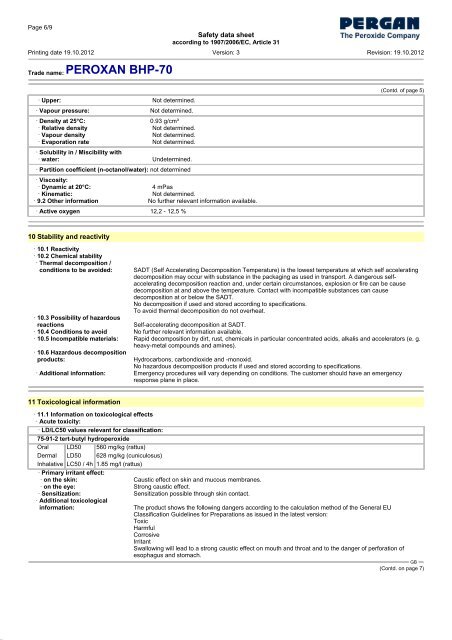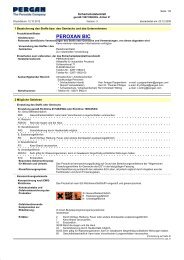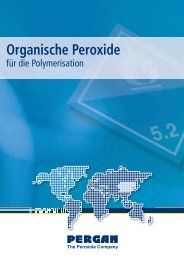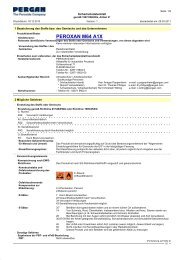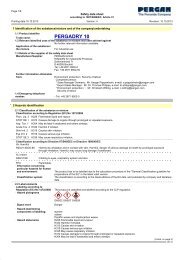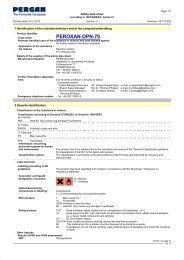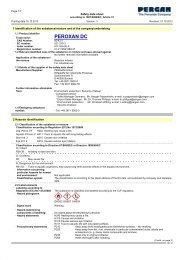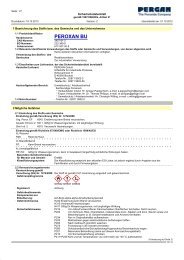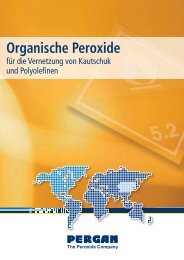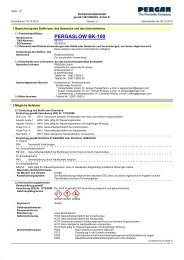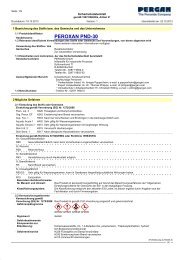PEROXAN BHP-70 - Pergan GmbH
PEROXAN BHP-70 - Pergan GmbH
PEROXAN BHP-70 - Pergan GmbH
Create successful ePaper yourself
Turn your PDF publications into a flip-book with our unique Google optimized e-Paper software.
35.0.33<br />
Page 6/9<br />
Printing date 19.10.2012<br />
Safety data sheet<br />
according to 1907/2006/EC, Article 31<br />
Version: 3<br />
Revision: 19.10.2012<br />
Trade name: <strong>PEROXAN</strong> <strong>BHP</strong>-<strong>70</strong><br />
· Upper: Not determined.<br />
· Vapour pressure: Not determined.<br />
· Density at 25°C: 0.93 g/cm³<br />
· Relative density Not determined.<br />
· Vapour density Not determined.<br />
· Evaporation rate Not determined.<br />
· Solubility in / Miscibility with<br />
· water: Undetermined.<br />
· Partition coefficient (n-octanol/water): not determined<br />
· Viscosity:<br />
· Dynamic at 20°C: 4 mPas<br />
· Kinematic: Not determined.<br />
· 9.2 Other information No further relevant information available.<br />
· Active oxygen 12,2 - 12,5 %<br />
10 Stability and reactivity<br />
(Contd. of page 5)<br />
· 10.1 Reactivity<br />
· 10.2 Chemical stability<br />
· Thermal decomposition /<br />
conditions to be avoided: SADT (Self Accelerating Decomposition Temperature) is the lowest temperature at which self accelerating<br />
decomposition may occur with substance in the packaging as used in transport. A dangerous selfaccelerating<br />
decomposition reaction and, under certain circumstances, explosion or fire can be cause<br />
decomposition at and above the temperature. Contact with incompatible substances can cause<br />
decomposition at or below the SADT.<br />
No decomposition if used and stored according to specifications.<br />
To avoid thermal decomposition do not overheat.<br />
· 10.3 Possibility of hazardous<br />
reactions Self-accelerating decomposition at SADT.<br />
· 10.4 Conditions to avoid No further relevant information available.<br />
· 10.5 Incompatible materials: Rapid decomposition by dirt, rust, chemicals in particular concentrated acids, alkalis and accelerators (e. g.<br />
heavy-metal compounds and amines).<br />
· 10.6 Hazardous decomposition<br />
products: Hydrocarbons, carbondioxide and -monoxid.<br />
No hazardous decomposition products if used and stored according to specifications.<br />
· Additional information: Emergency procedures will vary depending on conditions. The customer should have an emergency<br />
response plane in place.<br />
11 Toxicological information<br />
· 11.1 Information on toxicological effects<br />
· Acute toxicity:<br />
· LD/LC50 values relevant for classification:<br />
75-91-2 tert-butyl hydroperoxide<br />
Oral LD50 560 mg/kg (rattus)<br />
Dermal LD50 628 mg/kg (cuniculosus)<br />
Inhalative LC50 / 4h 1.85 mg/l (rattus)<br />
· Primary irritant effect:<br />
· on the skin: Caustic effect on skin and mucous membranes.<br />
· on the eye: Strong caustic effect.<br />
· Sensitization:<br />
· Additional toxicological<br />
Sensitization possible through skin contact.<br />
information: The product shows the following dangers according to the calculation method of the General EU<br />
Classification Guidelines for Preparations as issued in the latest version:<br />
Toxic<br />
Harmful<br />
Corrosive<br />
Irritant<br />
Swallowing will lead to a strong caustic effect on mouth and throat and to the danger of perforation of<br />
esophagus and stomach.<br />
GB<br />
(Contd. on page 7)


